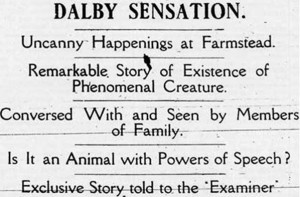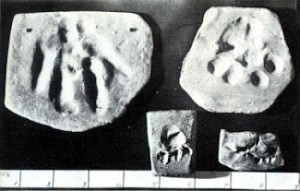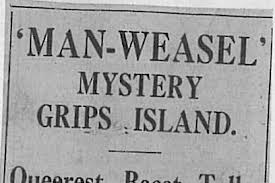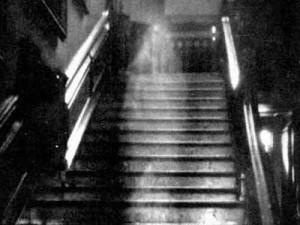“To believers it will represent proof of a miracle; to skeptics a lesson in the laws of evidence. Some will call it nonsense from first to last; others will admit it to be at least as good as most ghost stories.”—Harry Price and R.S. Lambert, The Haunting of Cashen’s Gap

The bizarre tale of Gef the talking mongoose started off harmlessly enough – if you consider some relatively minor poltergeist activity harmless. It all began in the fall of 1931 on a remote farm called Doarlish Cashen near the village of Dalby on the Isle of Man. The residents of Doarlish Cashen, James and Margaret Irving and their daughter Voirrey, saw an unusual animal resembling a weasel near their chicken coop. They said it was small (9-12” body), yellow and had a bushy, black speckled tail. Strangely, their chickens didn’t seem to mind the presence of this potential predator. They later saw this animal inside their house and it started keeping them awake at night by growling and spitting from behind the matchboard partition that covered the stone interior walls. There was a gap of a few inches between the panels and the walls, and this apparently gave the creature plenty of room to roam the house unseen. It also seemed to enjoy throwing small objects around from time to time.
It wasn’t long before Jack, as they were calling him at the time, started mimicking animal noises that James Irving started teaching him for some reason. Within a few days, all James had to do was say the name of an animal and Jack would make the corresponding sound. A short time later, it started reciting nursery rhymes and singing hymns that it had picked up from Voirrey, and then conversing with the family in a shrill, high-pitched voice. Gef, as he now wanted to be called (pronounced Jeff but spelled out as G-E-F by the creature), initially claimed to be the ghost of a weasel who was there to haunt them with weird noises and rattling chains. Later on, he changed his story and said that he was just an extra, extra clever mongoose born in India in 1852, making him extra old as well. In addition to English, he would also sometimes speak a language he claimed was Russian, sing in Spanish and once recited a poem in Welsh. There are other sources that claim Gef spoke additional languages, but I’m not convinced that they’ve got their facts straight on a number of things.
As absurd as a mongoose living on the Isle of Man might sound, it has been reported that a nearby farm imported some mongooses in 1912 to help control the rabbit population. There has even been a smattering of alleged mongoose sightings there in recent years, although I find all of the above somewhat suspect. Other places have also imported mongooses for pest control reasons and ended up regretting it. Most mongoose species are very fertile and these places soon found themselves up to their ears in them. I’m not sure how the Isle of Man would have avoided that problem.
It is not mentioned which species was supposedly brought in, but the Irving’s description sounds like a yellow mongoose, but they are native to Africa, not India. Gef claimed to be a marsh mongoose, also native to Africa and not yellow or bushy tailed. They’re also much larger than Gef. The closest mongoose to match the description and nationality given is probably the small Asian mongoose. None of this probably matters as Gef was most likely not a mongoose at all. On one occasion James and Voirrey claimed to have seen a large striped cat which seemed to have vanished when James chased it. Gef later claimed that this had been him. He also sometimes left dead rabbits on the Irving’s doorstep as gifts. They had always been strangled, which is not how a mongoose kills its prey, so who knows what he really was or looked like? There were even more physical inconsistencies which would emerge that I’ll get to later.
“If you knew what I know, you’d know a hell of a lot.”—Gef
Early on in his stay with the Irvings, Gef would be alternately congenial and menacing. In December of 1931, shortly after his arrival, he became so threatening towards Voirrey that her parents moved her bed into their room. Gef’s response to this was to tell them “I’ll follow her wherever you move her.” That night, James barricaded the bedroom door. After they had gone to bed, they noticed that the top part of the door above the barricade started to bulge inward as if under a great deal of stress. A few moments later they heard Gef say “I’m coming in,” and a pot of ointment then flew across the room and smashed against the bedframe. He also once told the family that he could kill them all if he wanted to. He quickly added that he didn’t want to, but the implied threat was still there. I’m pretty sure that I could kill the family next door if I was so inclined, but I’ve never felt the need to point this out to them.
At some unspecified point, the Irvings got so fed up with his antics that they threatened to move out if he didn’t clean up his act. That did the trick for the most part, and Gef was much more amicable after that. Whatever he was, Gef seemed to feel a real connection to the Irvings and didn’t want them to leave.
 Gef came to the attention of Harry Price, Britain’s foremost paranormal investigator at the time, in the winter of 1932 when he received a letter from an Irving family friend. He originally dismissed it as being a ridiculous story, but upon reflection decided that it might be worth a look. A reporter from the Manchester Daily Dispatch had already visited the farm and written that he found the Irvings to be honest people unlikely to be playing such an elaborate practical joke for no discernible reason. He further stated that he couldn’t imagine that a human could be responsible for the voice of Gef and that he was at a loss to explain some of his experiences there. Price decided that if there really was a talking mongoose out there, he wanted to know about it. Since he was too busy to go himself, he sent his friend Captain Dennis.
Gef came to the attention of Harry Price, Britain’s foremost paranormal investigator at the time, in the winter of 1932 when he received a letter from an Irving family friend. He originally dismissed it as being a ridiculous story, but upon reflection decided that it might be worth a look. A reporter from the Manchester Daily Dispatch had already visited the farm and written that he found the Irvings to be honest people unlikely to be playing such an elaborate practical joke for no discernible reason. He further stated that he couldn’t imagine that a human could be responsible for the voice of Gef and that he was at a loss to explain some of his experiences there. Price decided that if there really was a talking mongoose out there, he wanted to know about it. Since he was too busy to go himself, he sent his friend Captain Dennis.
“I like Captain Dennis, but not Harry Price. He’s the man who puts the kybosh on the spirits!”—Gef
Naturally, those who did and do believe that the whole affair was a hoax consider Voirrey to be the prime suspect. She was the focus of most of Gef’s attention and was almost always present whenever Gef was around. She was also likely the only one who could produce such a high-pitched voice. However, if she was the culprit, she never admitted it. In 1970, a reporter for Fate magazine tracked her down for an interview. She maintained that Gef was real and said that she wished that the whole thing had never happened. She blamed him for her having to leave the Isle of Man to escape the constant ridicule and lived in fear of someone she knew finding out about her past. She blamed her father for bringing public attention to these events because Gef became something of an obsession for him. Others who knew James Irving flatly dismissed the idea that Voirrey and/or Margaret were putting one over on him. He was not some credulous and illiterate country hick. He had been a successful businessman and had only moved his family to that remote farm because he thought that raising sheep would be a simpler and more relaxing life.
In any case, Captain Dennis visited the farm on three separate occasions and had several experiences with Gef sans Voirrey. In one instance, he and James were outside when they heard Gef’s voice quite close by. Dennis knew that both Margaret and Voirrey were inside the house some distance away at the time. On another occasion, he heard Gef speak from behind the paneling with both James and Margaret in the room while Voirrey was clearly visible outside feeding the chickens a hundred feet away. The most memorable of his encounters with Gef occurred on a night when he had insisted that Voirrey be locked in her room to ensure that she could not be responsible for anything that might transpire. Gef evidently took exception to this. All of a sudden, the house erupted with the sound of shrill screams and loud banging and knocking coming from all around the house in rapid succession. When Dennis was returning from upstairs to make certain that Voirrey was still locked in her room, a bottle and china tray came flying down from the top of the staircase and smashed on the floor. This was followed by the sound of mocking laughter. The knocking continued into the early morning hours when Gef was asked to stop. At that point he announced “I’ll throw pebbles now at the windows,” and immediately there was the sound of gravel and small stones hitting the window panes. If Voirrey was able to pull all of this off while locked in her room, she was clearly a girl with remarkable abilities.
Gef also liked to get out and visit the surrounding area every once in a while. He regularly accompanied the Irvings on trips into town, yapping away the whole time, although always out of sight behind the thick hedges that lined the road. More impressively, he also sometimes took the bus to the nearby town of Peel, apparently just to spy on the workers at the bus depot there and report back to James. One of the bus drivers got so tired of this that he set a trap for Gef. The trap supposedly consisted of an electrified plate rigged up underneath the bus. That’s a lot of trouble to go through over some harmless gossip, much less a hoax. Gef also allegedly stole some sandwiches from a bus conductor. The man claimed that the bag they were in appeared to have been sliced open with some kind of sharp object. Most thieves would have just taken the whole bag. Another driver who lived in Peel supposedly told one of the Irving’s friends that he had no choice but to believe in Gef after Mr. Irving was able to accurately describe the interior of his house despite having never been inside.
 The physical evidence for Gef is less impressive. Fur samples he left for analysis turned out to be from a dog, probably the Irving’s sheepdog. Footprint impressions he made in clay sent by Harry Price didn’t match any known animal, certainly not a mongoose. His front paws were way too big for a creature his size and all lacked the detail that would be present in actual prints. Gef did claim that his feet were huge…and then some. “I am a freak. I have hands and I have feet, and if you saw me you’d faint, you’d be petrified, mummified, turned into stone or a pillar of salt.” Enough people saw Gef, or at least caught a glimpse of him, that this can safely be considered a bit of an exaggeration. Many of Gef’s other statements were equally over the top, some revealing either delusions of grandeur or quite a flare for the dramatic, such as when he called himself the eighth wonder of the world or his claim that he was the Holy Ghost.
The physical evidence for Gef is less impressive. Fur samples he left for analysis turned out to be from a dog, probably the Irving’s sheepdog. Footprint impressions he made in clay sent by Harry Price didn’t match any known animal, certainly not a mongoose. His front paws were way too big for a creature his size and all lacked the detail that would be present in actual prints. Gef did claim that his feet were huge…and then some. “I am a freak. I have hands and I have feet, and if you saw me you’d faint, you’d be petrified, mummified, turned into stone or a pillar of salt.” Enough people saw Gef, or at least caught a glimpse of him, that this can safely be considered a bit of an exaggeration. Many of Gef’s other statements were equally over the top, some revealing either delusions of grandeur or quite a flare for the dramatic, such as when he called himself the eighth wonder of the world or his claim that he was the Holy Ghost.
No consensus has ever been reached either then or now as to what Gef really was. Harry Price, despite writing a book in which he called Gef a “modern miracle,” considered the whole thing to be a hoax. This is perhaps understandable since he eventually did make several visits to the farm without ever seeing or experiencing anything out of the ordinary. However, one could argue that if Gef was a hoax, wouldn’t the hoaxers be extra motivated to put on a show for Britain’s most well-known paranormal investigator? Gef said that he didn’t like Price because he was the one who “puts the kybosh” on spirits. Maybe that’s why he chose to avoid him. On the other hand, his friend Captain Dennis was convinced that Gef was real, as was the noted Hungarian paranormal investigator Nandor Fodor. He also visited the farm and had some interesting experiences with Gef.
“I have three attractions: I follow Voirrey, Mam gives me food, and Jim answers my questions.”—Gef
Among those who do believe in Gef, most consider him to have been a very unusual kind of poltergeist. All of the knocking on walls and throwing things is pretty standard poltergeist behavior. Also, there was his attachment to Voirrey. Poltergeists do have a proclivity for teenagers, especially teenage girls. For those of you who don’t know, the difference between a poltergeist and a typical ghost is that ghosts are usually associated with a place, whereas poltergeists are attached to a particular person and follow them around. Since most paranormal researchers think that poltergeists are an unconscious manifestation of the latent psychic powers of the person that they are attached to, that would make Gef an unconscious creation of Voirrey. Others think that they are roaming spirits who are attracted to the hormonally charged energy that exudes from adolescents. That energy is what they use to throw stuff around, set fires, move furniture, etc.
But as Fodor pointed out, there’s never been any kind of spirit like Gef. He ate the food the Irvings left out for him and left behind the gnawed remains of what he didn’t finish. He killed over two dozen rabbits by strangling them and left them for the family to cook for dinner. Gef was also very talkative for a spirit. Disembodied voices aren’t unheard of (no pun intended) in poltergeist cases, but ones that carry on genial conversations are pretty rare. There was also somewhere in the neighborhood of 20 people who claimed to have seen Gef, or at least part of him. There’s no other known case of a poltergeist appearing to be some type of physical creature. But if he was an actual mongoose, why wouldn’t he provide real fur and footprint evidence to support this? And a real mongoose would have eaten those rabbits. Maybe he found the idea of eating raw rabbits as distasteful as we would. He obviously preferred the cooked sausages, chocolate and bananas that the Irvings left out for him. Not exactly your typical mongoose diet.
He sometimes claimed to be a spirit, but when asked where he would go when he died replied “to Hell, to the land of mist.” There’s a bit of a logical inconsistency there. If he was a spirit, presumably he had already died. Unless he considered the Isle of Man to be Hell, that doesn’t make much sense, although the “land of mist” could be considered an accurate assessment of the place, no offense intended to the good people of the island.

If Gef was a poltergeist, he may have been more connected to James Irving than to Voirrey, despite his saying that he “followed” her. In a letter to Harry Price, James recounted how in the early days of Gef’s appearance he would sometimes plead “Oh let me go Jim. Let me go.” When James told him to go ahead and go already, Gef would call out “Vanished,” which would then be followed by complete silence until the next time he showed up at the house. This possible connection to James is further evidenced by the fact that Gef did vanish for good in 1944 at about the same time that James became ill with pernicious anemia. He died in 1945, and Margaret sold the farm and moved away shortly thereafter. The new owner denied ever having any sort of bizarre experiences there. The house was later torn down for unspecified reasons, which is a bit odd in itself. There are still many old, abandoned farmhouses in the area. Why go to the expense of tearing down and hauling away the remains of this one when so many others were left standing?
“Of course I know what I am, and you are not going to get to know, and you are only grigged because I won’t tell you. I might let you see me some time, but thou will never get to know what I am.”—Gef
Almost nothing was written about Gef’s exploits after around 1937, despite the fact that he seems to have hung around until sometime in 1944. I guess the investigators just ran out of things to investigate. A family friend, Charles Morrison, said that Gef stopped talking around 1940, but they still heard him moving around the house. 1940 may have been when Voirrey left home, but I have no way of knowing that. I only know that she left because it has been recorded that she returned in 1944 to help her mother care for her ailing father. Their oldest daughter Elsie had also returned. She had left home before the whole Gef saga began. She told Morrison how, at the time of her father’s death, she and her mother saw the branch that they kept on the mantle to sweep out the fireplace start to move back and forth. She said that it stopped just as her father died. Perhaps this was Gef saying goodbye.
Just to add a final bit of intrigue to a story that appears so absurd on the surface, there is supposedly an Indian legend that mongooses can learn to speak, although I’ve been unable to confirm this. Even if it’s true, similar legends exist around the world involving different sorts of animals, so it’s hardly unique. Still, it’s an interesting coincidence. How likely is it that a family in Great Britain would be aware of an obscure Indian legend?
 It’s unlikely that we’ll ever know what Gef really was. There’s never been anything like him reported before or since, which is why I’m so taken with him. In a paranormal world filled with spooky ghosts, menacing aliens and hairy monsters, he’s a perplexing breath of fresh air. Why can’t we have more Gefs and fewer grays? Whatever he was or is, he can crash at my place anytime. Sausages and bananas are cheap, and I always have chocolate around. Then again, maybe I should be careful what I wish for.
It’s unlikely that we’ll ever know what Gef really was. There’s never been anything like him reported before or since, which is why I’m so taken with him. In a paranormal world filled with spooky ghosts, menacing aliens and hairy monsters, he’s a perplexing breath of fresh air. Why can’t we have more Gefs and fewer grays? Whatever he was or is, he can crash at my place anytime. Sausages and bananas are cheap, and I always have chocolate around. Then again, maybe I should be careful what I wish for.


 First, since consciousness controls reality, reality may be far more malleable than we think. Need proof? I give you the placebo effect. We all know how this works. You give someone a sugar pill or an injection of saline solution and tell them that it’s a powerful new wonder drug and they get better. But how? Just like some real drugs can trick your brain into smelling things that aren’t there, placebos trick your brain into thinking that you will get better, and so you do. It was your thoughts – your consciousness – that healed you. Patients in clinical drug trials can even be told that they may be given placebos and they still get better while some people given the actual drug get worse. How is that scientifically possible if we’re just biological machines and nothing more?
First, since consciousness controls reality, reality may be far more malleable than we think. Need proof? I give you the placebo effect. We all know how this works. You give someone a sugar pill or an injection of saline solution and tell them that it’s a powerful new wonder drug and they get better. But how? Just like some real drugs can trick your brain into smelling things that aren’t there, placebos trick your brain into thinking that you will get better, and so you do. It was your thoughts – your consciousness – that healed you. Patients in clinical drug trials can even be told that they may be given placebos and they still get better while some people given the actual drug get worse. How is that scientifically possible if we’re just biological machines and nothing more? be aware of its surroundings? That’s like talking to a movie screen and having the characters answer you back. However, if consciousness permeates everything, it seems possible that even a psychic impression might possess a form of awareness, even if the person that they are but an image of is long gone. Add to that the belief in some cultures that the soul, which is really just the spiritual term for consciousness, has multiple levels.
be aware of its surroundings? That’s like talking to a movie screen and having the characters answer you back. However, if consciousness permeates everything, it seems possible that even a psychic impression might possess a form of awareness, even if the person that they are but an image of is long gone. Add to that the belief in some cultures that the soul, which is really just the spiritual term for consciousness, has multiple levels. world we live in. In fact, they believed that our reality was generated by that one, an idea very similar to Bohm’s theory of the explicate order being created out of the implicate. They also pondered the apparent contradiction that one could only access this greater reality by going inside one’s own mind. Apparently, they were not familiar with the mystical aphorism “the greatest is in the smallest,” or the alchemists’ motto “as above, so below.” And they certainly could never have guessed the “whole in each part” nature of the hologram, much less that our reality might be one.
world we live in. In fact, they believed that our reality was generated by that one, an idea very similar to Bohm’s theory of the explicate order being created out of the implicate. They also pondered the apparent contradiction that one could only access this greater reality by going inside one’s own mind. Apparently, they were not familiar with the mystical aphorism “the greatest is in the smallest,” or the alchemists’ motto “as above, so below.” And they certainly could never have guessed the “whole in each part” nature of the hologram, much less that our reality might be one.